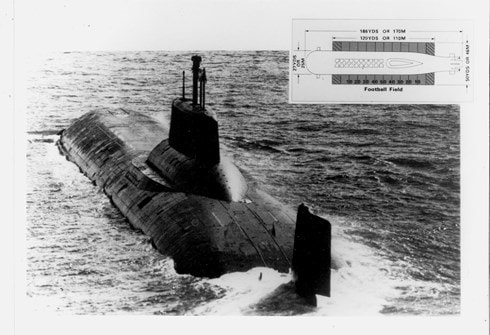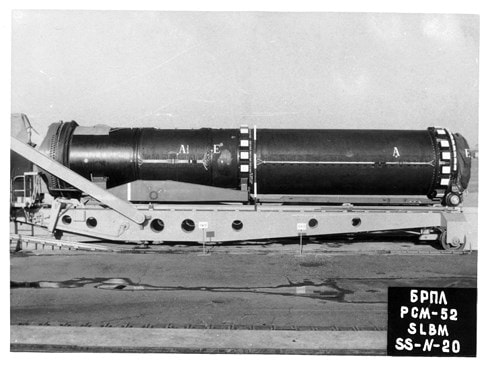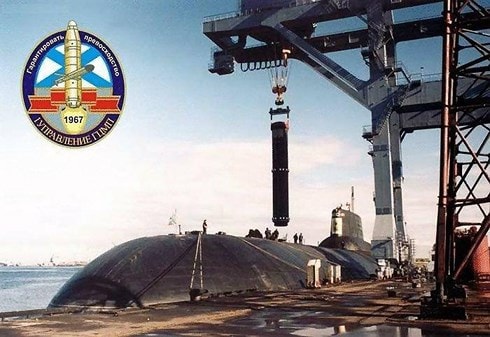The reason Russia let the "Sea Monster" under the ocean Akula "retire"
The Project 941 Akula-class submarine, known as the Typhoon by NATO, was built to strengthen the Soviet Union's nuclear deterrent.
According to Russian media, the Russian Navy will retire the world's two largest strategic nuclear submarines of the Project 941 Akula class, Arkhangelsk and Severstal. Accordingly, after 2020, the Russian State Atomic Energy Corporation "Rosatom" will liquidate the two nuclear submarines "Arkhangelsk" and "Severstal".
|
| Russia's Akula submarine is also known as the "sea monster" of the ocean. Photo: Sputnik |
Many military experts expressed regret at the retirement of the two submarines that were once Russia's strategic nuclear deterrent. However, analysts said that there are many reasons why the Russian Navy no longer needs Project 941 submarines to maintain its nuclear deterrent.
Simply because it is a giant…
Built between 1976 and 1986, the Akula submarines played an important role in the nuclear deterrence triad of the former Soviet Union and present-day Russia.
The Akula-class submarine currently holds the world record for size. The ship is 175 m long; 23 m wide; has a displacement of 48,000 tons; is equipped with 2 OK-650 nuclear reactors with a capacity of 190 MW; 2 gas turbine engines allow the ship to reach a maximum speed of 50 km/h when submerged, dive to a depth of 400 m, and dive continuously for 120 days at sea. The Akula can respond to the need to launch surprise attacks with ballistic missiles in case the Soviet Union is attacked by nuclear weapons.
The Akulas helped Moscow balance the nuclear balance with the United States, leading to later late-Soviet and post-Soviet nuclear treaties in the form of the START agreements. However, some observers said the boats were too large and too expensive even in their heyday.
“The Project 941 submarines are giants and the ships themselves are extremely expensive,” said Konstantin Makienko, deputy director of the Moscow-based Center for Analysis of Strategies and Technologies. “They are a counterweight to the US Ohio-class nuclear submarines.”
|
| Akula-class submarines hold the world record for size at 175 m long and 23 m wide. Photo: Sputnik |
“However, while the US was capable of building up to 18 Ohio-class submarines, a powerful Soviet Union at that time could only build six Akula submarines,” Mr. Makienko added.
The strategic armament of the Akula submarines consists of 20 R-39 intercontinental ballistic missiles, carrying 10 MIRV nuclear warheads of 100-200 kilotons, for a maximum range of 8,300km. With a total weight of 95 tons, the R39 is the largest intercontinental ballistic missile ever built, and is three times heavier than the US Trident C-4 missile and one and a half times heavier than the Trident II D-5, although the Trident II D-5 far exceeds the R-39 in both explosives and range.
Russian military expert Vadim Saranov assessed: "The displacement of an Akula-class submarine when fully loaded is about 20,000 tons, while an Ohio-class submarine is only about 18,500 tons and it can carry up to 24 Trident II D-5 missiles compared to 20 R-39 missiles that Aluka can carry."
…and extremely expensive
One of the perceived advantages of the Akula is its size. This size theoretically allows it to penetrate the thickest Arctic ice with sheer force.
However, Mr. Saramov reiterated that this is not always true in reality. In 1990, the TK-202 Akula failed to break through the thick Arctic ice to surface after dozens of attempts. Even after returning to base, the crew discovered damage to the hull, sensors and some other appendages.
With their massive bodies, Akula-class submarines require special docks for mooring, as well as high costs to maintain operations. According to expert Saranov, the maintenance and repair costs for each Akula-class submarine are at least twice as high as the operating costs of 667BDR Kalmar and 667BDRM Delphin - two ballistic missile submarines designed to be smaller but still carry up to 16 ballistic missiles, only 4 missiles less than the Akula-class submarine.
|
| R-39 missile, strategic weapon of Akula-class submarine. Photo: Pinterest |
There were also other costs for Akula-related infrastructure, including a special 40km railway in the Murmansk region to transport the R-39 missiles. Heavy cranes were also built to be able to move the R-39 missiles down to the submarine's launch silos.
The maintenance and repair of Akula-class submarines also requires the super-massive PD-50 floating dock. Currently, this floating dock is used for the heavy aircraft-carrying missile cruiser Admiral Kuznetsov.
Regret for the "ocean monster"
With the economic turmoil following the collapse of the Soviet Union, three Akulas were no longer in service. The Severstal and Archangelsk were decommissioned in 2004 and 2006, respectively, and have been in reserve ever since, around the same time the R-39 missiles reached their operational life.
Military expert Konstantin Sivkov believes that retiring the two Akulas is a mistake and a waste. “The US has experience in converting the missiles used on Ohio-class SSBNs from Trident ballistic missiles to Tomahawk land-attack cruise missiles. I think we can do the same with Project 941. If an Ohio-class submarine can carry 150 Tomahawks, the Akula can carry up to 250 missiles.”
|
| The transfer of R-39 missiles to the launch wells on Akula-class submarines requires a systemheavy crane system. Photo: Wikimapia |
However, many other analysts believe that the cost of maintaining the operations of the Akula giants is very expensive, and upgrading, modernizing and equipping these ships with new weapons will also cost billions of dollars.
Mr. Makienko also emphasized that due to limited defense budget conditions, Russia has recently decided to shift to manufacturing small surface ships of several thousand tons and nuclear submarines with displacement of around 10,000 tons, while eliminating these super-large but expensive submarines.
The Russian Navy now has cruise missile submarines that are “more mobile and more economical to operate” than the “sea monster” Akula.
The fate of the Akula strategic nuclear submarines is almost certain. However, before being officially retired, the Akula-class submarines will serve as a training ground for crews and testing weapons for the new Project 955 Borei submarines.
It also plays a supporting role in the development of the Bulava, a new missile for the Project 955 Borei submarines that will replace all Project 667 and Project 941 nuclear missile submarines in service with the Russian Navy.
This is to ensure that Russia's nuclear deterrence mission will continue to be effectively maintained./.




